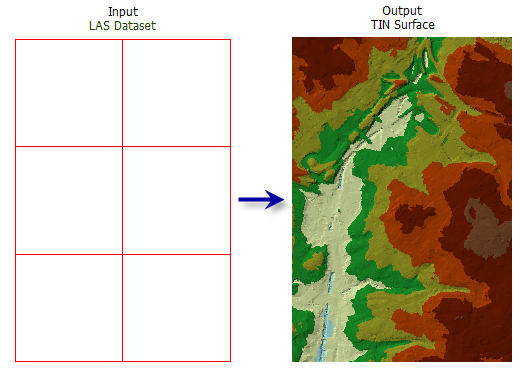| Label | Explanation | Data Type |
Input LAS Dataset | The LAS dataset that will be processed. | LAS Dataset Layer |
Output TIN | The TIN dataset that will be generated. | TIN |
Thinning Type (Optional) | Specifies the type of thinning to be used to reduce the LAS data points saved as the nodes in the resulting TIN.
| String |
Thinning Method
(Optional) | Specifies the technique to be used to reduce the LAS data points, which impacts the interpretation of Thinning Value. The available options depend on the selected Thinning Type.
| String |
Thinning Value
(Optional) | The thinning value's interpretation depends on the selection made for Thinning Type. If Thinning Type is set to Window Size, this value represents the sampling area by which the LAS dataset will be divided. If Thinning Type is set to Random and Thinning Method is set to Percent, this value represents the percentage of LAS points that will be exported to the TIN. If Thinning Type is set to Random and Thinning Method is set to Node Count, this value represents the total number of LAS points that can be exported to the TIN. | Double |
Maximum Number of Output Nodes
(Optional) | The maximum number of nodes permitted in the output TIN. The default is 5 million. | Double |
Z Factor (Optional) | The factor by which z-values will be multiplied. This is typically used to convert z linear units to match x,y linear units. The default is 1, which leaves elevation values unchanged. This parameter is not available if the spatial reference of the input surface has a z-datum with a specified linear unit. | Double |
Clip to Extent (Optional) | Specifies whether the resulting TIN will be clipped against the analysis extent. This only has an effect if the analysis extent is a subset of the input LAS dataset.
| Boolean |
Summary
Exports a triangulated irregular network (TIN) from a LAS dataset.
Illustration

Usage
-
You can have the LAS dataset layer limit the LAS points that are displayed and processed by selecting any combination of classification codes, classification flags, and return values in the layer's filter settings. The filters can be defined on the Layer Properties dialog box or in the Make LAS Dataset Layer tool.
-
The LAS dataset layer can also be used to control the enforcement of surface constraint features that may be referenced by the LAS dataset. The constraints are enforced when displaying or processing the LAS dataset as a triangulated surface.
While the total number of points that a TIN can support can exceed 15 million points, it is recommended that you limit TIN datasets to no more than 5 million points to ensure a responsive performance when displaying and analyzing the data. The TIN node count can be reduced using point thinning methods and controlling the output processing extent.
Note:
Consider using a Window Size thinning type (thinning_type="WINDOW_SIZE" in Python) when you need more predictable control of how LAS points are thinned in the generation of the output TIN.
Parameters
arcpy.ddd.LasDatasetToTin(in_las_dataset, out_tin, {thinning_type}, {thinning_method}, {thinning_value}, {max_nodes}, {z_factor}, {clip_to_extent})| Name | Explanation | Data Type |
in_las_dataset | The LAS dataset that will be processed. | LAS Dataset Layer |
out_tin | The TIN dataset that will be generated. | TIN |
thinning_type (Optional) | Specifies the technique to be used to select a subset of LAS data points that will be exported to TIN.
| String |
thinning_method (Optional) | Specifies the technique to be used to reduce the LAS data points, which impacts the interpretation of Thinning Value. The available options depend on the selected Thinning Type.
Specifies the technique to be used to reduce the LAS data points, which impacts the interpretation of the thinning_value. The available options depend on the selected thinning_type.
| String |
thinning_value (Optional) | If thinning_type="WINDOW_SIZE", this value represents the sampling area by which the LAS dataset will be divided. If thinning_type="RANDOM" and thinning_method="PERCENT", this value represents the percentage of points from the LAS dataset that will be exported to the TIN. If thinning_type="RANDOM" and thinning_method="NODE_COUNT", this value represents the total number of LAS points that can be exported to the TIN. | Double |
max_nodes (Optional) | The maximum number of nodes permitted in the output TIN. The default is 5 million. | Double |
z_factor (Optional) | The factor by which z-values will be multiplied. This is typically used to convert z linear units to match x,y linear units. The default is 1, which leaves elevation values unchanged. This parameter is not available if the spatial reference of the input surface has a z-datum with a specified linear unit. | Double |
clip_to_extent (Optional) | Specifies whether the resulting TIN will be clipped against the analysis extent. This only has an effect if the analysis extent is a subset of the input LAS dataset.
| Boolean |
Code sample
The following sample demonstrates the use of this tool in the Python window:
arcpy.env.workspace = 'C:/data'
arcpy.ddd.LasDatasetToTin('se_baltimore.lasd', 'se_bmore', 'RANDOM', 15, 3.28)The following sample demonstrates the use of this tool in a stand-alone Python script:
'''**********************************************************************
Name: LAS Dataset to TIN Example
Description: Create a TIN using bare earth lidar measurements. This
script is designed for use as a script tool.
**********************************************************************'''
# Import system modules
import arcpy
# Set Local Variables
lasD = arcpy.GetParameterAsText(0)
inLas = arcpy.GetParameterAsText(1) #input las files
surfCons = arcpy.GetParameterAsText(2) #input surface constraints
sr = arcpy.GetParameter(3) #spatial reference of las dataset
outTin = arcpy.GetParameterAsText(4)
thinningType = arcpy.GetParameterAsText(5)
thinningMethod = arcpy.GetParameterAsText(6)
thinningValue = arcpy.GetParameter(7)
zFactor = arcpy.GetParameter(8)
# Execute CreateLasDataset
arcpy.management.CreateLasDataset(inLas, lasD, 'RECURSION', surfCons, sr)
lasLyr = arcpy.CreateUniqueName('lasdToTin', 'in_memory')
classCode = 2
returnValue = 'LAST'
# Execute MakeLasDatasetLayer
arcpy.management.MakeLasDatasetLayer(lasD, lasLyr, classCode, returnValue)
# Define extent of the area of interest
env.extent(1426057, 606477, 1449836, 623246)
# Execute LasDatasetToTin
arcpy.ddd.LasDatasetToTin(lasLyr, outTin, thinningType,
thinningMethod, thinningValue, zFactor)Environments
Licensing information
- Basic: Requires 3D Analyst
- Standard: Requires 3D Analyst
- Advanced: Requires 3D Analyst